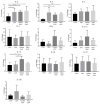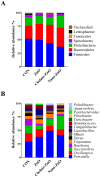Changes in Diarrhea Score, Nutrient Digestibility, Zinc Utilization, Intestinal Immune Profiles, and Fecal Microbiome in Weaned Piglets by Different Forms of Zinc
- PMID: 34064626
- PMCID: PMC8151337
- DOI: 10.3390/ani11051356
Changes in Diarrhea Score, Nutrient Digestibility, Zinc Utilization, Intestinal Immune Profiles, and Fecal Microbiome in Weaned Piglets by Different Forms of Zinc
Abstract
Twenty weaned piglets with initial body weight of 6.83 ± 0.33 kg (21 day of age, LYD) were randomly assigned to four treatments for a two-week feeding trial to determine the effects of different dietary zinc on nutrient digestibility, intestinal health, and microbiome of weaned piglets. The dietary treatments included a negative control (CON), standard ZnO (ZnO, 2500 ppm), zinc chelate with glycine (Chelate-ZnO, 200 ppm), and nanoparticle-sized ZnO (Nano-ZnO, 200 ppm). At 0 to 1 week, the diarrhea score was decreased in the CON group compared with the ZnO, Chelate-ZnO, and Nano-ZnO group. In overall period, the ZnO and Nano-ZnO groups exhibited improved diarrhea scores compared to the CON group. The apparent total tract digestibility of dry matter and gross energy was the lowest in the CON group after one week. Compared to the ZnO group, the chelate-ZnO group exhibited higher proportion of T-bet+ and FoxP3+ T cells and the nano-ZnO group had higher numbers of RORgt+ and GATA3+ T cells in the mesenteric lymph nodes. ZnO group increased IL-6 and IL-8 levels in the colon tissues and these positive effects were observed in both chelate ZnO and nano-ZnO groups with lower level. The 16S rRNA gene analysis showed that the relative abundance of Prevotella was higher in the ZnO-treated groups than in the CON group and that of Succinivibrio was the highest in the nano-ZnO group. The relative abundance of Lactobacillus increased in the ZnO group. In conclusion, low nano-ZnO levels have similar effects on nutrient digestibility, fecal microflora, and intestinal immune profiles in weaning pigs; thus, nano-ZnO could be used as a ZnO alternative for promoting ZnO utilization and intestinal immunity.
Keywords: ZnO alternative; digestibility; immune; microbiome; piglets.
Conflict of interest statement
The authors declare no conflict of interest.
Figures











References
-
- Lallès J.P., Bosi P., Smidt H., Stokes C.R. Weaning—A challenge to gut physiologists. Livest. Sci. 2007;108:82–93. doi: 10.1016/j.livsci.2007.01.091. - DOI
LinkOut - more resources
Full Text Sources

